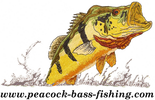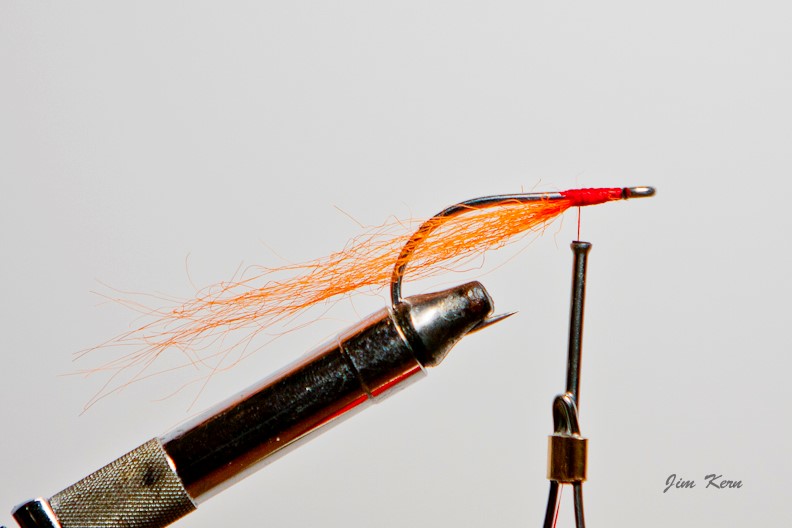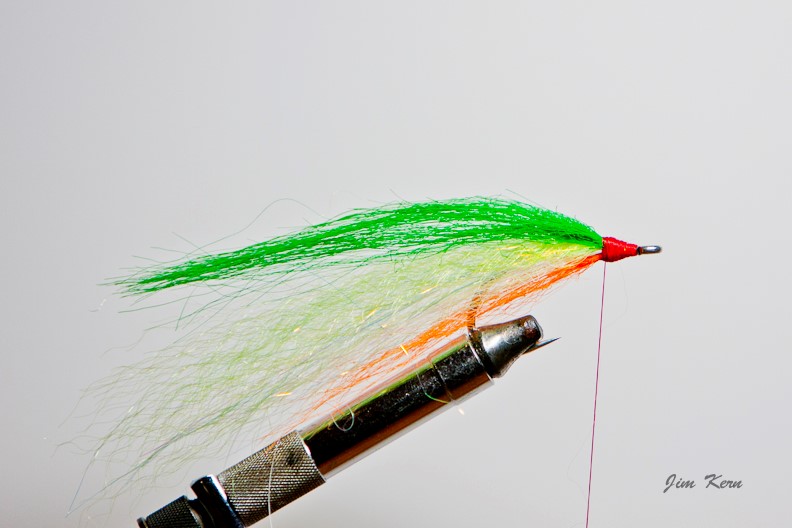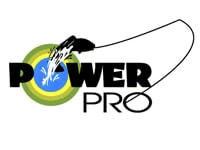Tying Peacock Bass Flies
By: Jim Kern
Peacock bass will readily hit flies, both top water and subsurface, but most peacocks are caught subsurface as that is where they consume over 90% of their prey. I have found that big Deceivers are the most effective style of fly to use day in and day out in all water conditions. These flies can be fished at different depths utilizing different types of fly lines and have also proven to be very effective when trolling on bait casting and spinning equipment. Following are some of the fly patterns I have found effective for peacock bass as well as materials and techniques used in tying these big 4 – 6 inch Deceivers that I call “Gorilla Flies”.
Patterns
The areas I have fished for the last 17 years on the black waters of the upper Rio Negro, basically from 50 miles downstream of Barcelos to 50 miles upstream of Ste Isabelle, is the freshwater tropical fish capital of the world. It is estimated that over 50 million Tropical fish are exported from Barcelos (a town of about 25,000 located about 300 miles upriver from Manaus) each year. Peacock bass will eat most every type of fish they can catch, including juveniles of their own species, fresh water sardines, oscars, piranha, baitfish & a myriad of colorful tropical fish. The colors of prominence in drawing a peacock's attention in the dark brown tannin colored waters are red, yellow and white. Big eyes on the flies really seem to increase the number of strikes you will get & the native fishing guides all seem to favor red eyes. Below are some of the patterns I tie.
Hooks
Hooks must be big and strong as it is necessary to get the hook implanted behind the big roll of a lip the larger Peacock Bass sport, thus I utilize Gamakatsu’s 4/0 Saltwater hooks for all my Gorilla Flies. I like medium to short shank hooks and use Gamakatsu’s SC15-2H saltwater series hooks. I have never had one let me down!
Thread
I like to use Flat Waxed Nylon for tying these large Deceivers as it is strong and durable and does not build up the head too big when tying a number of layers of material on the fly. I use Zap A Gap super glue about every other layer of material I add to the fly to make the flies durable.
Body Material
Peacock bass are hard fighters and will quickly tear up a fly made of feathers and delicate body materials. The best materials I have found is Fish hair that has been “frizzed” with a hot air gun to kink up the material which makes for a much fuller fly body. The most durable material I have found is extruded Nylon sold under the name of “Salt Water Yak Hair.” This extruded Nylon is big time coarse, tough and is what I use for flies intended for trolling. Adding strands of Flash -A-Bo &/or a layer of “sparkly” material such as Steve Farrar’s “Flash Blend” will give the fly a little glitter and life. The problem is if the Piranha find this flash appealing, they will trim the fly back to the hook in short order.
Eyes
Adding eyes to the fly will usually increase the number of strikes several fold. I personal like holographic eyes as they tend to catch a little of the color of the material they are glued onto. The native guides on the river you will be fishing with will always pick a fly with a red eye over one with a clear eye.
Fly Size
The “big fish big fly” idea was prominent when I started fly fishing for Peacock in 1997 when we were tying flies 6 – 9 inches long trying to appeal to the Big Peacocks and keep the little ones from striking. After 28 trips to the upper Rio Negro in Brazil’s Amazon and having fished with some of the best fly fishermen in the world including Lefty Kreh, Rick Pope, Bill Elliott & Rufus Wakeman, our attitudes have changed. The preferred fly size is from 4 to 5, maybe 6 inches. You are not going to keep the voracious 2 -4 lb’ers from striking the larger flies and the Big Peacocks will hit a 4 or 5 inch fly just as quick as they will a 8 or 9 inch fly & you will enjoy your day much more working that smaller fly.
Fly Tying Instructions
Juvenile Peacock Fly Pattern
1) Tie a small clump of orange Fish Hair under the hook. Add a film of head cement to the threads.
2) Tie a clump of white Fish Hair on the top of the hook.
3) Tie about 10 strands of Flash-A-Bo on top of hook.
4) Tie a clump of pale olive Flash Blend on top of hook.
5) Tie a clump of green Fish Hair on top of hook
6) Tie a clump of dark olive Fish Hair forward from the hook eye.
7) Pull the clump back, wrapping tightly in front and finish head of fly.
8) Glue eyes on the fly head with 5 min. Epoxy and allow to dry. Then add a thin layer of 5 min Epoxy to finish off head for strength. When fly has dried, add stripes on side of fly with a felt marker.
Tie the flies on with a loop knot that will enhance the movement of the fly in the water. Retrieve the Gorilla Flies in short fast jerks, allowing the fly to hesitate and sink every 3 or 4 strips & hang on!!!

















